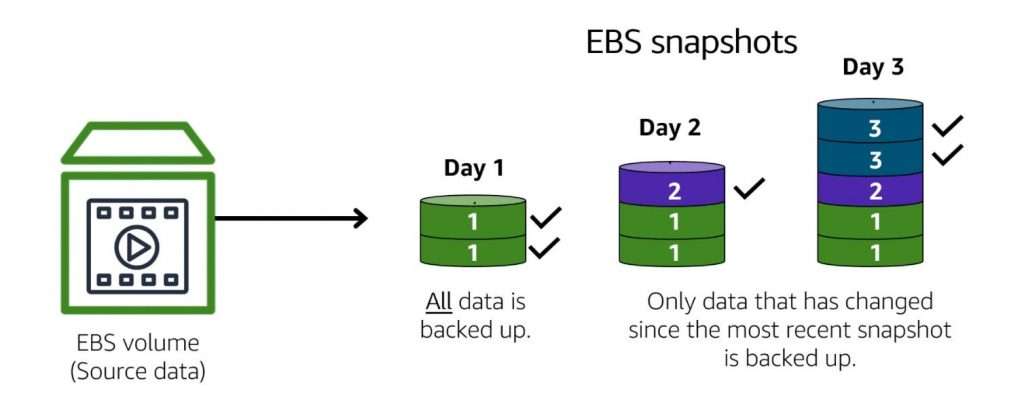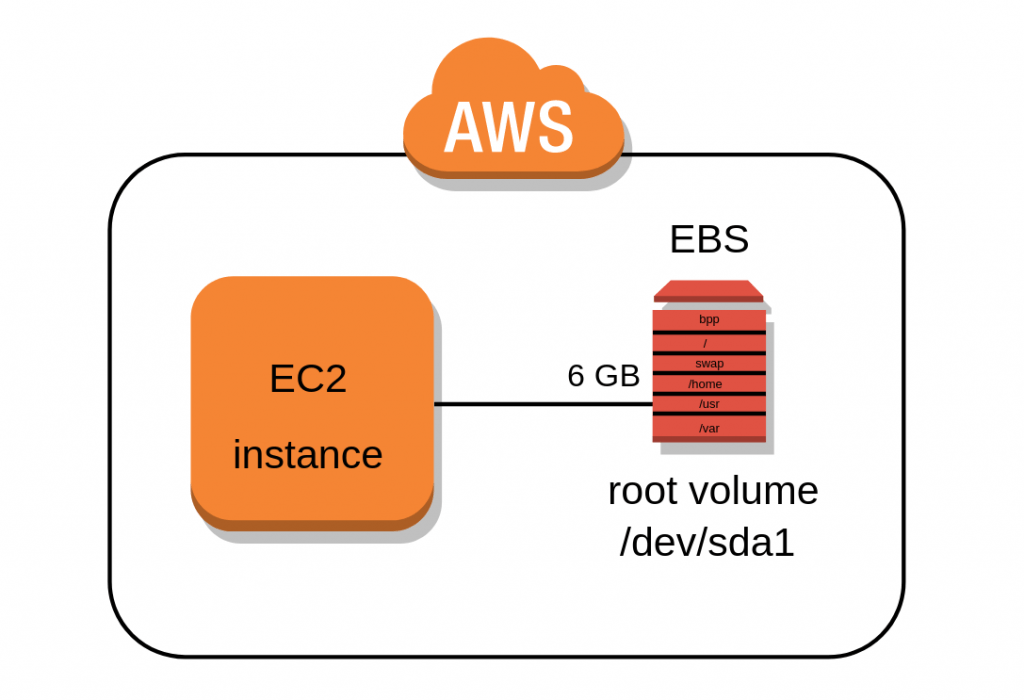
- Introduction to AWS EBS
- Key Features of AWS EBS
- How AWS EBS Works
- Types of AWS EBS Volumes
- Benefits of AWS EBS
- AWS EBS Pricing
- How to Set Up AWS EBS
- Best Practices for AWS EBS
- Use Cases of AWS EBS
- AWS EBS vs. Other Storage Solutions
- Conclusion
Introduction to AWS EBS
AWS Elastic Block Store (EBS) is a fully managed, scalable, high-performance block storage service provided by Amazon Web Services. It is designed for Amazon EC2 instances, providing persistent, low-latency storage. EBS volumes are virtual hard drives used for various workloads that require fast and consistent performance, such as databases, applications, and file systems. Unlike instance store volumes, which are temporary storage solutions, EBS volumes persist independently of the EC2 instances to which they are attached. Your data is retained even when an EC2 instance is stopped or terminated. Additionally, EBS is highly reliable, as it automatically replicates data across multiple servers within an Availability Zone to provide redundancy and protect against hardware failures.
Key Features of AWS EBS
- Persistence: AWS EBS volumes retain data even when the associated EC2 instance is stopped or terminated. This ensures operational continuity and protects against data loss during instance lifecycle changes.
- Scalability: EBS offers flexible storage capacity ranging from 1 GiB to 16 TiB per volume. This allows businesses to scale their storage seamlessly as their needs grow, without downtime.
- General Purpose SSD (gp3): This volume type balances performance and cost. It’s ideal for a wide range of workloads, including boot volumes, web servers, and development/test environments. It supports up to 16,000 IOPS and 1,000 MB/s throughput.
- Provisioned IOPS SSD (io2): Designed for I/O-intensive applications like large databases and real-time analytics, io2 offers high durability and performance with up to 256,000 IOPS and 4,000 MB/s throughput. It’s perfect for mission-critical workloads requiring consistent low latency.
- Throughput-Optimized HDD (st1): Optimized for large, sequential workloads such as big data processing and data warehousing. st1 provides high throughput at a lower cost, making it suitable for streaming workloads that require consistent performance.
- Snapshots: EBS supports creating point-in-time snapshots stored in Amazon S3. These snapshots are incremental, saving only changes since the last snapshot, which reduces storage costs and speeds up backup and recovery processes.
- Incremental Backups: With support for incremental backups, EBS enables efficient storage management by only saving the changes made since the last backup, minimizing time and space required.
- Encryption: EBS volumes can be encrypted at rest and in transit. AWS Key Management Service (KMS) manages the encryption keys, ensuring data confidentiality and compliance with security standards.
How AWS EBS Works
At its core, AWS EBS operates by creating volumes that can be attached to Amazon EC2 instances. These volumes are block-level storage devices, similar to hard or solid-state drives (SSDs) in physical machines. When a volume is attached to an EC2 instance, it behaves like a local disk that can be formatted and used like any other hard drive. One of EBS’s defining characteristics is its persistent nature. While EC2 instances are ephemeral and can be terminated, EBS volumes continue to exist independently. This makes EBS an excellent choice for storing data that needs to persist across instance restarts or even terminations. Furthermore, volumes can be resized or moved between EC2 instances, offering flexibility when scaling your infrastructure. Another critical aspect of EBS is its data redundancy. Volumes are automatically replicated within an Availability Zone, ensuring data durability in case of hardware failures. This replication ensures that your data remains available and reliable, even if one of the underlying hardware components fails.

Types of AWS EBS Volumes
AWS offers several EBS volumes to cater to different use cases, allowing users to select the Volume that best meets their performance and cost needs. The main volume types are:
- General Purpose SSD (gp3): This volume type balances performance and cost. It suits most workloads, including boot volumes, low-latency applications, and development environments. It delivers up to 16,000 IOPS (input/output operations per second) and up to 1,000 MB/s throughput.
- Provisioned IOPS SSD (io2): Designed for high-performance workloads that require low latency and high throughput, such as databases and data analytics. It offers 256,000 IOPS and up to 4,000 MB/s throughput, making it ideal for mission-critical applications where performance is paramount.
- Throughput Optimized HDD (st1): These volumes are optimized for sequential read and write operations, making them suitable for big data processing and log storage applications. While they offer lower performance than SSDs, they are a cost-effective solution for workloads requiring high throughput but tolerating moderate latency.
- Cold HDD (sc1): This is the lowest-cost EBS volume type, designed for infrequently accessed data. It is ideal for workloads such as archival storage and backup solutions, where performance is less critical and the data is accessed sporadically.
Each volume type is tailored to specific applications, so it’s essential to select the one that aligns with your performance and cost requirements.
Benefits of AWS EBS
One of the primary benefits of AWS EBS is its reliability. Since EBS volumes are automatically replicated across multiple servers within an Availability Zone, they offer high durability and availability. This makes EBS ideal for storing critical data that needs to be protected against hardware failures. EBS also provides flexibility and scalability. As your storage needs grow, you can easily resize your EBS volumes without downtime, making it easier to scale your infrastructure according to your application’s demands. Additionally, the ability to create snapshots of your volumes and restore them as needed provides a simple and effective disaster recovery solution. The performance options offered by AWS EBS are another significant advantage. Whether you need low-latency access for a high-performance database or moderate throughput for archival data, EBS provides multiple volume types to suit various application needs. For example, provisioned IOPS SSD volumes (io2) are perfect for high-performance databases, while cold HDD volumes (sc1) are ideal for long-term storage at a low cost. Security is another key benefit of EBS. With features like data encryption at rest and in transit, as well as integration with AWS Key Management Service (KMS), your data is protected against unauthorized access.
AWS EBS Pricing
AWS EBS pricing is based on several factors, including the type of volume, the amount of storage provisioned, and the level of performance required. Pricing is generally based on a pay-as-you-go model, meaning you pay only for the storage and performance you use.
- Volume Storage: The cost of the volume depends on its type and size. For instance, general-purpose SSD volumes (gp3) are less expensive than Provisioned IOPS SSD volumes (io2), which are designed for high-performance use cases.
- Provisioned IOPS: If you choose an IOPS-intensive volume type like io2, you are billed for the provisioned IOPS and storage capacity.
- Snapshot Storage: Taking snapshots of your EBS volumes also incurs charges, but since snapshots are incremental, you are only charged for the amount of new data added since the last snapshot.
- Data Transfer: You will incur additional costs if you transfer data between different AWS regions, although transferring data within the same Availability Zone is free.
AWS EBS provides a cost-effective and flexible pricing model that allows businesses to optimize their cloud infrastructure costs based on their storage needs.
How to Set Up AWS EBS
Setting up an AWS EBS volume is a straightforward process that involves a few essential steps. First, navigate to the AWS Management Console and select the EBS service to create a new volume. During this step, you can choose the desired volume size, type, and availability zone based on your requirements. Once the volume is created, the next step is to attach it to an EC2 instance. This can be done directly from the EBS dashboard by selecting the volume and linking it to the appropriate instance. After attachment, you’ll need to format and mount the volume. For Linux-based instances, standard commands like mkfs are used to format the volume, and it can be mounted using standard mount commands. For Windows instances, formatting and mounting can be done through the Disk Management tool. Once the volume is successfully formatted and mounted, it’s ready to be used just like a regular hard drive, enabling you to store, read, and write data seamlessly.

Best Practices for AWS EBS
To ensure that you get the most out of AWS EBS, here are a few best practices:
- Choose the Right Volume Type: The correct volume type is crucial for achieving optimal performance and cost-efficiency. For example, consider using Provisioned IOPS SSD (io2) for best results if running a high-performance database.
- Monitor Performance: Use Amazon CloudWatch to monitor your EBS volumes’ performance metrics, such as throughput, IOPS, and latency. This will help you identify performance bottlenecks and optimize your setup.
- Take Regular Snapshots: Regular snapshots provide a simple and reliable backup solution for your data. Since snapshots are incremental, they are cost-effective and allow you to restore your data quickly in case of failure.
- Use EBS-Optimized Instances: To maximize the performance of your EBS volumes, ensure that you are using EBS-optimized EC2 instances. These instances are designed to provide dedicated bandwidth for EBS, resulting in more consistent performance.
- Secure Your Data: Always enable encryption for your EBS volumes to protect your data both at rest and in transit. Leverage AWS Key Management Service (KMS) to manage your encryption keys.
Use Cases of AWS EBS
AWS EBS is ideal for a wide range of use cases, including
- Database Storage: EBS is commonly used for storing databases like MySQL, PostgreSQL, and Oracle, where low-latency access and high IOPS are critical for performance.
- Big Data and Analytics: For applications involving large amounts of data, such as Hadoop or data warehousing, EBS provides the throughput required to handle the workload efficiently.
- Backup and Recovery: EBS snapshots make it easy to back up and restore data in case of disaster.
- File Systems and Applications: Many applications that require fast and consistent data access, including web servers and enterprise applications, rely on EBS for persistent storage.
AWS EBS vs. Other Storage Solutions
When comparing AWS EBS to other AWS storage solutions, there are a few key differences:
- EBS vs. Amazon S3: While Amazon S3 is an object storage service, EBS provides block-level storage. S3 is designed for large amounts of unstructured data, while EBS is ideal for applications that require low-latency, persistent block storage.
- EBS vs. Amazon EFS: Amazon EFS is a file storage service that can be accessed by multiple EC2 instances simultaneously, whereas EBS is designed for single-instance use. EFS is suitable for shared file systems, while EBS is ideal for high-performance block storage.
- EBS vs. Instance Store: Instance store volumes are temporary storage tied to the lifecycle of an EC2 instance, whereas EBS volumes are persistent and can survive instance terminations.
Conclusion
AWS EBS is a robust, reliable, scalable block storage service that provides persistent storage for Amazon EC2 instances. With various volume types, encryption options, and high availability, EBS is suitable for multiple use cases, from database storage to backup and recovery. By following best practices and selecting the right volume type, businesses can optimize their storage solutions and maximize the performance of their applications.





